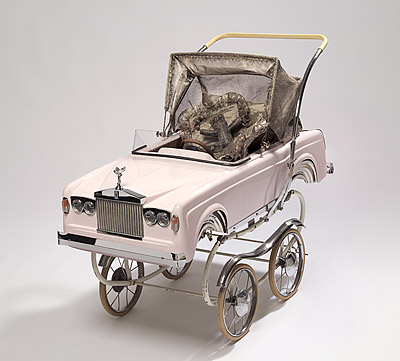Shaelene
MURRAY
Australia
1960
Kiddie-car
1998-2009
metal, stainless steel mesh, glass, wood
approx.
97.0 (h)
x 56.0 (w)
x 127.0 (d)
cm
Collection of the artist
Shaelene Murray’s work is concerned with family history, the fantastic, and notions of the feminine. She engages domestic objects and daily rituals―once common but now with an element of nostalgia―converting household appliances, kitchen tools, clotheslines and handbags.[1] In Kiddie-car, she manipulates metals to recall substances that are actually soft. The teddy bear, bedding, and elaborate sunshade of the carriage are painstakingly constructed from various gauges of stainless steel mesh of the type used for industrial machine filters. Hand-stitched, quilted, embroidered, beribboned and trimmed, the bear and ensemble are framed by the pram–car structure. Here, traditional handicrafts of the female domain are combined with the ‘masculine’ mechanical skills of the workshop.
The artist describes the visual delight of Kiddie-car, the surprise we feel on encountering the Rolls Royce and finding within it a metal knitted bear. From the shiny, chromed grill to the embroidered frilly pillow, we see luxury, detail and toy-like fantasy. But this hybrid object also suggests another, more complex reading:
Imagine Kiddie-car as a stage setting. The wheels, handle and retractable hood are the theatrical props reminiscent of the 1960s. The story, one of lived experience and the hand-me-down history of poverty, evident in the rust, scuffs and bruises on the Cyclops framework.
The second act, by comparison, is the carriage. The luxury Rolls Royce beautifully finished. Every detail polished and lovingly attended to. Enthroned in the car, surrounded by stainless steel trappings is Teddy. Arms up, waiting, Child gone.
Act three, conclusion. Kiddie-car’s story talks of family. Who was important in the family, who wasn’t. What was important, what wasn’t. Gifts of comfort, need be in steel, to last a lifetime. Mother struggling with poverty, polishing the second-hand, smiling to hide the shame. Child presented as proof of love, skill and quality, must succeed, must be perfect. Car as signifier of the Father tamed by the domestic and the reality of the domestic.[2]
Kiddie-car is the antithesis of the lightweight designer vehicles employed by today’s yummy mummies. The fact that the upper carriage is actually a car―with steering wheel, windshield, headlights and custom-made bonnet emblem―takes a moment to register. The beautifully crafted interior, featuring polished wooden panels and gorgeous steel-grey pillow and coverlet, stand in stark contrast to the chipped paint and scuffed wheels. The sheet, cast back, reveals the bemused little bear; he’s the kind carefully made as a gift, only to be discarded for a smarter store-bought item or something made in plastic. Still, Kiddie-car is exactly the sort of present which would delight any little boy or girl on a special birthday; a little extravagant, perhaps, a little hard and a little big. Boys know it would go faster if it was red, while girls quickly realise the awful truth: it doesn’t come with a baby doll. Homespun homilies, utilitarian items, and bizarre juxtapositions, Murray’s reinterpretations make us look twice.
Lucina Ward
Curator
International Painting and Sculpture
National Gallery of Australia, Canberra
[1] Murray’s other works in stainless steel wire and mesh include a manicure set, cups and tea sets, lavishly embroidered and decorated coat-hangers, and a set of three aprons titled (and inscribed) There’s no place like home 2001; Happy heart happy home 2001 and Mother knows best 2001. Firmly grounded in fine craft, jewellery and metalworking traditions, these works also refer to the period in the 1960s and 1970s when textile traditions infiltrated sculpture, largely as a result of feminist interventions.
[2] Artist statement, March 2009, NGA file 08/0662

